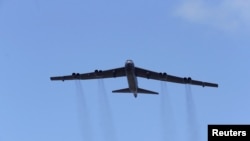In a sign that the United States is stepping up its military effort to shore up the now-stretched Afghan security forces against the Taliban resurgence, U.S. Air Force (USAF) Boeing B-52H Stratofortress strategic bombers are back in the Afghan skies.
The large aircraft played a pivotal role in forcing the hard-line Islamist Taliban regime out of power in 2001 after a U.S.-led international military coalition attacked Afghanistan following the 9/11 terrorist attacks.
U.S. authorities blamed Afghanistan-based Al-Qaeda militants for the attacks on its soil and launched a military offensive after the Taliban failed to hand over Al-Qaeda leaders.
This week, USAF Chief of Staff General David L. Goldfein announced the return of the massive bombers.
"We got the B-52 back in the fight in Afghanistan," Goldfein said in a press statement on August 16. "We have the B-52 contributing to a significant ground effort and employing weapons in close proximity of friendly troops who are under attack [and] who are preparing the battlefield in new ways."
The statement added that the B-52 used 27 bombs and missiles to support two counterterrorism operations. It is, however, not clear when exactly the operations resumed in Afghanistan after 10 years.
The return of the B-52 to the Afghan theater comes after U.S. President Barack Obama ordered in June that air power be used more proactively to support the Afghan forces in fending off a resilient Taliban insurgency. The USAF has conducted more than 800 sorties and more than 140 strikes in Afghanistan since June.
Since the departure of most NATO troops in late 2014, Afghan forces have lost large swathes of the countryside to the insurgents.
Media reports suggest that U.S. airstrikes have spiked in the eastern Afghan province of Nangarhar and southern Helmand Province, where Afghan forces are battling Islamic State (IS) and Taliban militants.
In Nangarhar, Afghan forces have reclaimed several mountainous district from IS. U.S. and Afghan officials say the group’s leader for Afghanistan and Pakistan, Hafiz Saeed Khan, was killed in an U.S. drone strike in Nangarhar’s Kot district on July 26.
This region also includes the Tora Bora cave complex, where the B-52 bombers reportedly pinned down Osama Bin Laden and other key Al-Qaeda leaders in late 2001 before anemic Afghan ground forces prevented them from slipping into neighboring Pakistan.
In Helmand, however, the U.S. airstrikes have not stopped the Taliban’s advances. After capturing several rural districts in recent weeks, the insurgents have virtually besieged the provincial capital, Lashkar Gah.
as/fg







